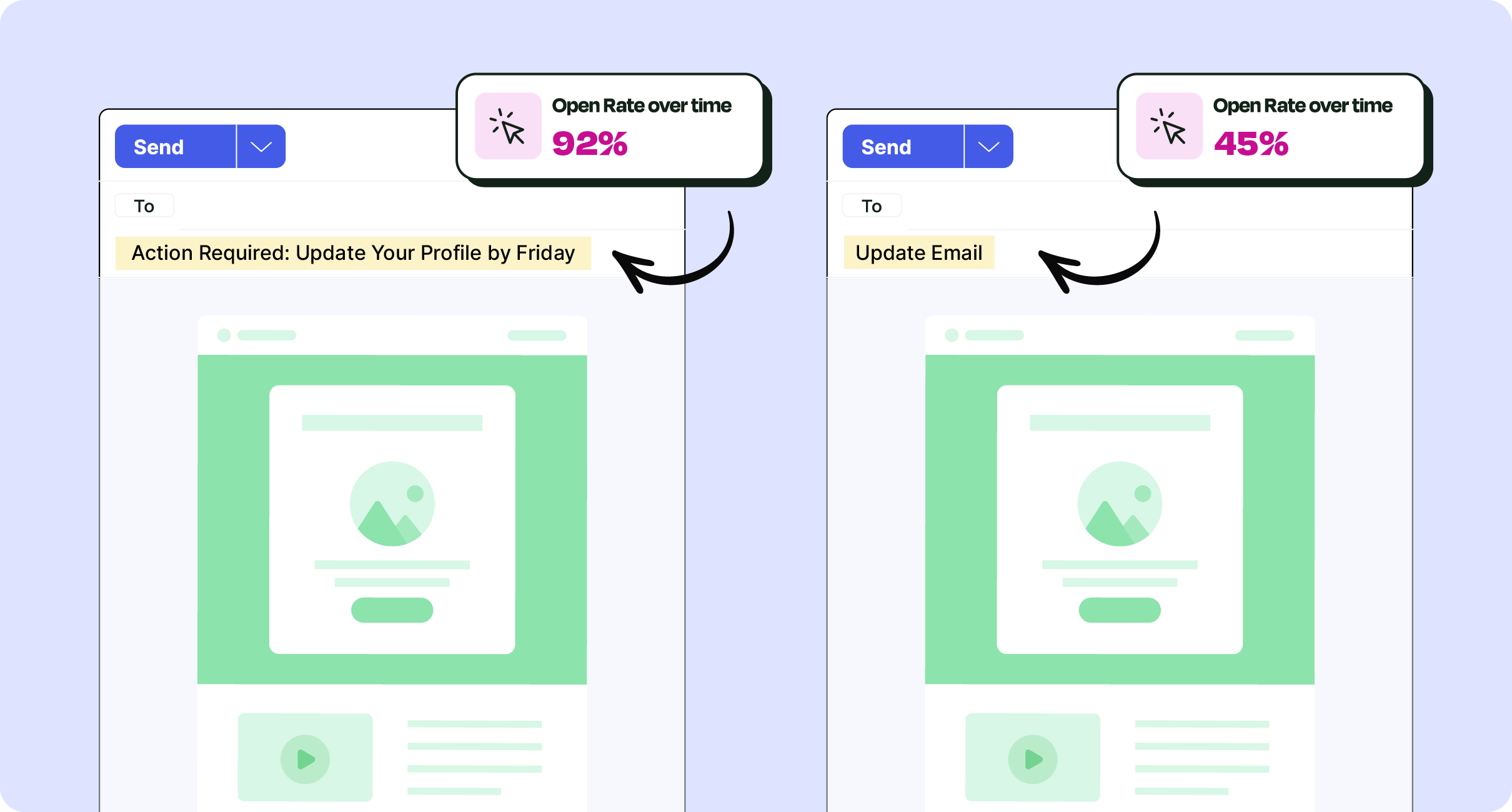How do you create content for employee engagement that connects your people? In this article, we’ll answer this question and arm you with an actionable employee content strategy that’ll actually move the needle.
When employees are engaged, your organization thrives. Strong employee engagement content does more than inform—it connects, inspires, and drives action. A well-planned employee content strategy ensures your workforce stays aligned, motivated, and productive.
That said, many organizations struggle to create content for employee engagement that truly resonates. What makes employee content compelling? Which types of employee content generate the most engagement? And how can you streamline employee content management to keep communications relevant and impactful?
In this guide, we’ll walk through employee content best practices and highlight real-world examples that capture attention. We’ll also share expert strategies for employee content marketing, helping you craft messages that activate your employees.
Take a self-guided tour of ContactMonkey
See how our key features can streamline your internal communications.
Take product tour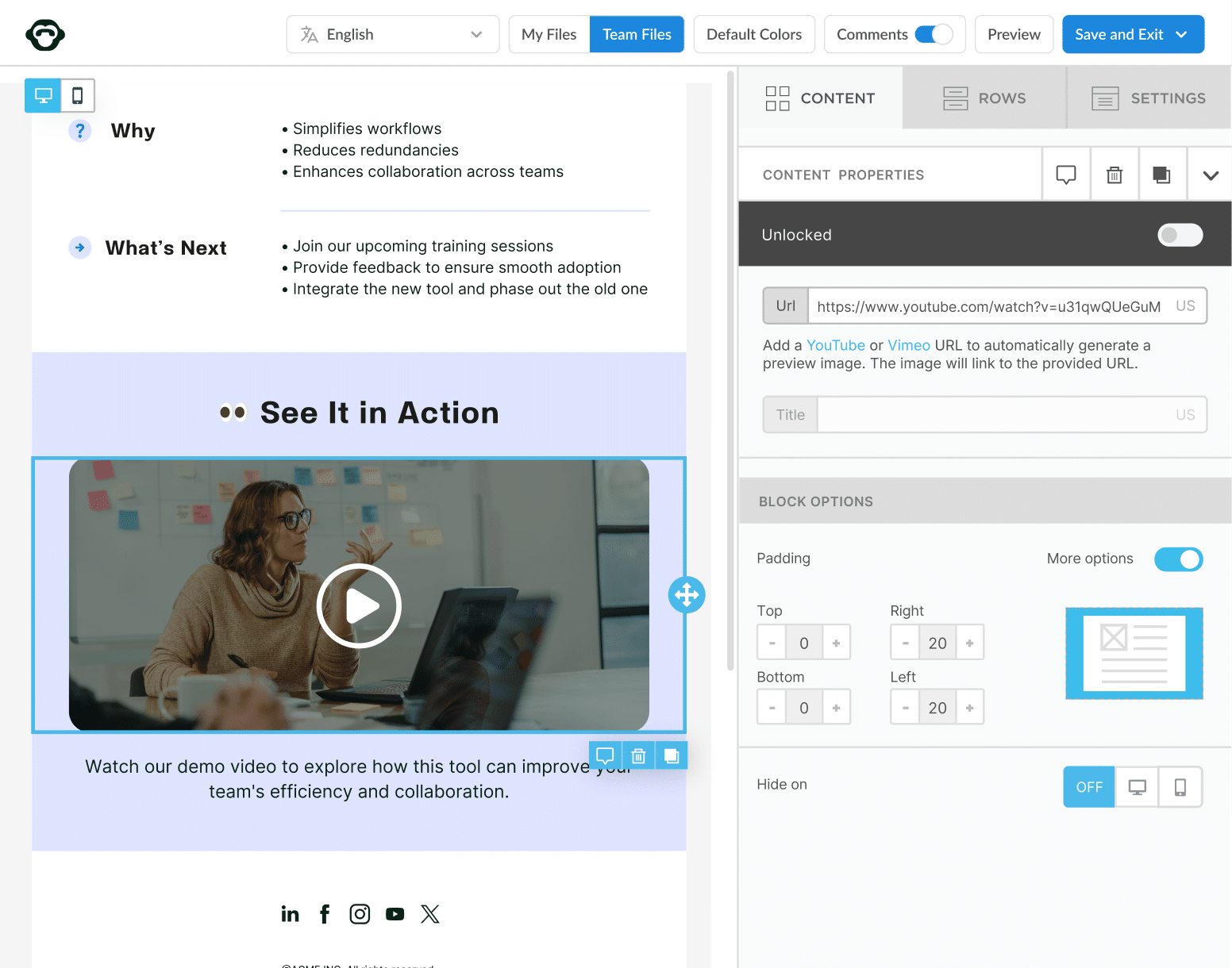
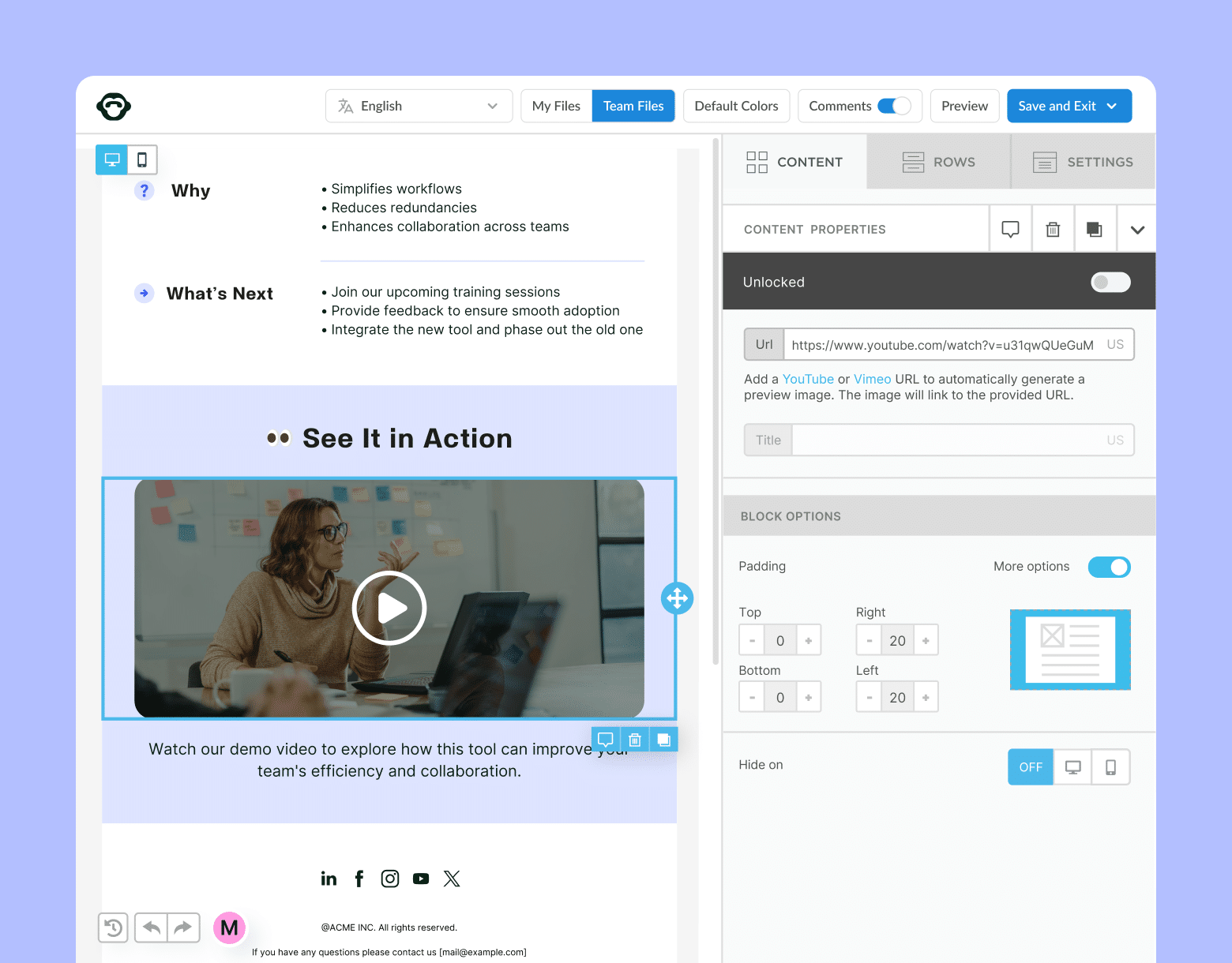
What is Employee Content?
Employee content refers to any material designed for your internal audience. This encompasses newsletters, training manuals, videos, podcasts, or even social media-style updates that keep your workforce informed and motivated.
Employee engagement content should foster a shared sense of purpose, cultivate trust, and reduce information overload. Whether it’s content for employee newsletter updates or specialized employee training content, well-crafted internal materials should inform and align your employees.
🎁 BONUS
Need some content brainstorming support? Visit our article on employee newsletter content ideas.
10 Types of Employee Content That Generate Engagement
Below are 10 types of employee content most likely to capture your workforce’s attention and inspire action. Each section includes why it works, tips to execute, an actionable example, key considerations, and quick tips for maximizing results.
1. Company updates and business changes
Keeping employees informed about organizational developments—like strategic shifts or policy changes—fosters trust and transparency.
Why it works: This is a foundational element of any employee content strategy, ensuring teams aren’t blindsided by new initiatives. Regular updates delivered as employee content also show respect for your workforce, which in turn strengthens engagement.
Tips to execute:
- Use employee newsletter content or staff newsletter content to highlight critical news.
- Create segmented mailing lists so the right people get the right updates.
- Combine text updates with visuals like charts or infographics to clarify complex information.
Modern internal comms and measurement tools
No design or technical expertise needed. Save time, increase engagement, and dazzle your employees with fun and interactive communications.
Explore all features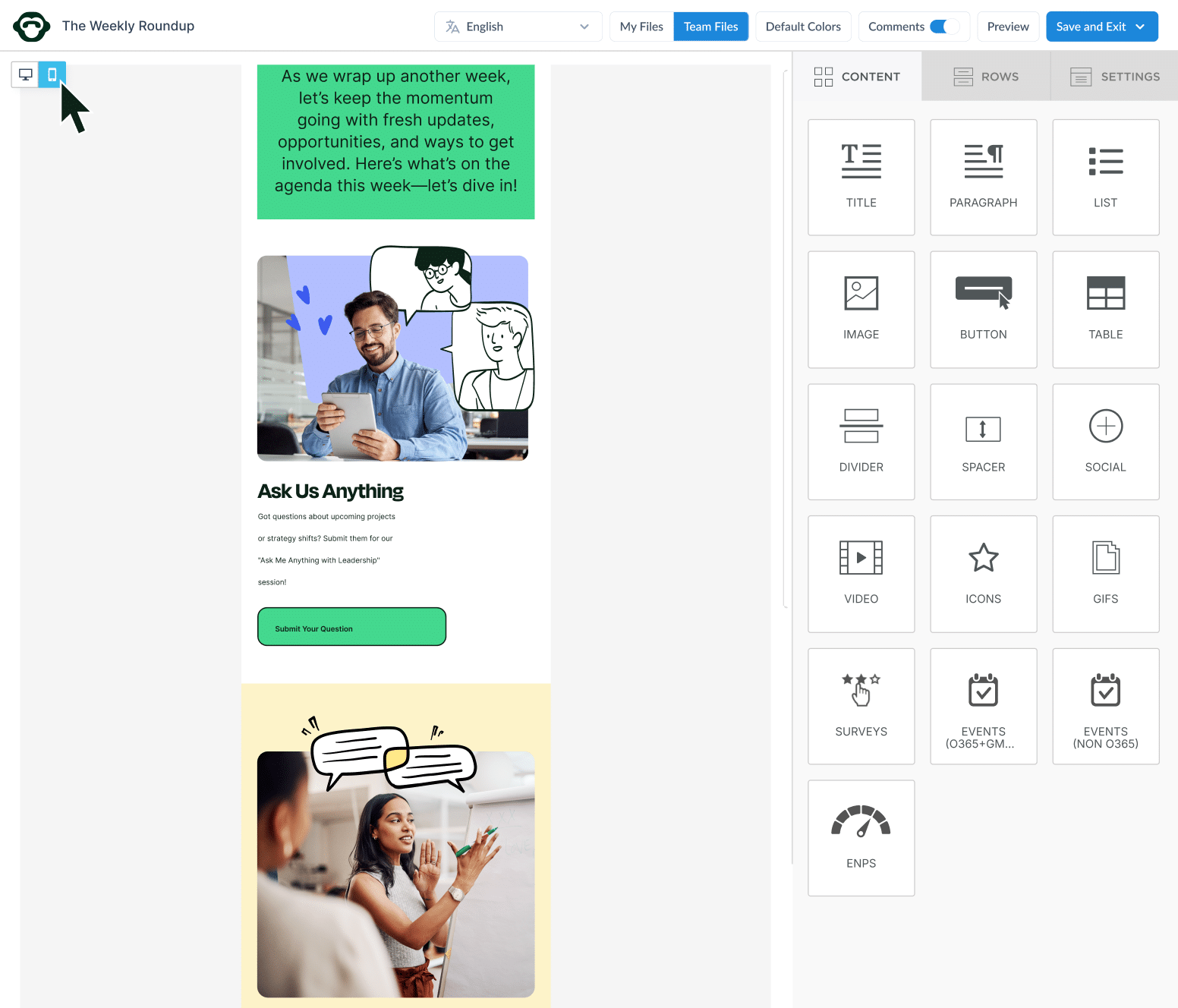
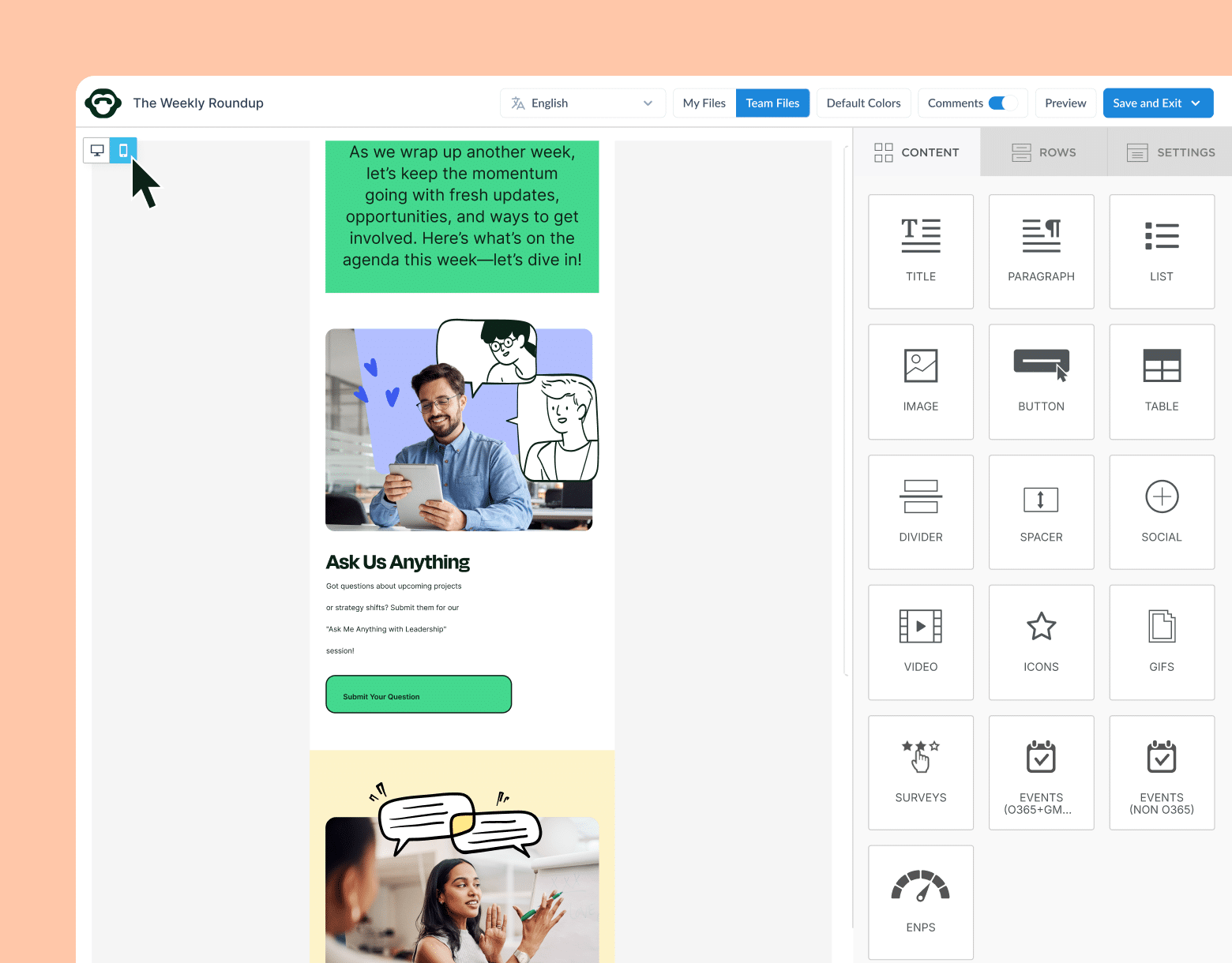
Actionable example: Send a monthly “State of the Business” email featuring performance highlights and upcoming changes. Include relevant employee content ideas like Q&A sections or polls to gather immediate feedback.
Considerations:
- Avoid overwhelming employees with minor announcements.
- Offer clear action steps when changes affect daily workflows.
PRO TIP
Encourage managers to follow up on big updates during team meetings, reinforcing how these shifts relate to individual employees.
2. Behind-the-scenes content and culture insights
People love peeking behind the curtain—especially when it reveals the human side of the company.
Why it works: Behind-the-scenes content highlights day-to-day operations and personal stories, encouraging empathy and unity. This employee engagement content can also strengthen corporate culture by spotlighting shared values.
Tips to execute:
- Capture short videos for internal communications or photos of team collaborations.
- Feature casual interviews with employees about ongoing projects.
- Add sections for employee voices in your staff newsletter content examples.
Actionable example: Organize a “Day in the Life” photo series on the intranet or employee newsletter content ideas. Each week, choose one department to showcase daily highlights—whether it’s brainstorming sessions, design mock-ups, or customer calls.
Considerations:
- Maintain privacy; ensure you have consent before sharing behind-the-scenes images or details.
- Balance candid shots with essential context so employees understand the relevance.
PRO TIP
Align behind-the-scenes stories with larger organizational objectives, reinforcing how every role contributes to the overall mission.
Watch ContactMonkey LIVE in action
Join live demo
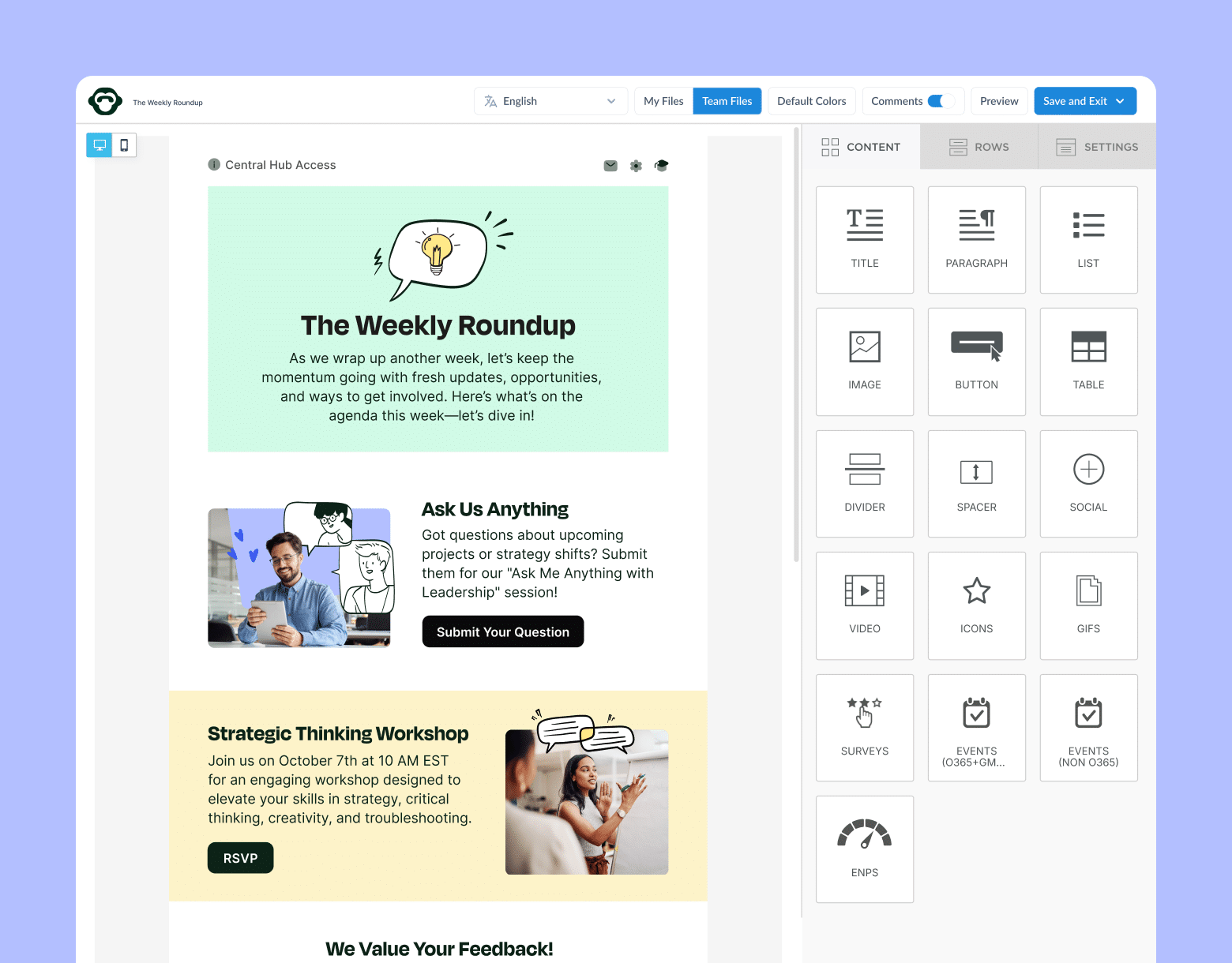
3. Employee spotlights and recognition
Spotlighting individuals or teams reinforces the idea that employee efforts matter.
Why it works: Public praise is a potent form of employee engagement content, boosting morale while showcasing role models. These employee content examples can also highlight best practices others can adopt.
Tips to execute:
- Dedicate a monthly section in your employee newsletter content to recognize high-achievers.
- Use peer-to-peer recognition tools where colleagues can nominate each other.
- Integrate fun awards like “Team Collaborator of the Month” or “Problem-Solving Hero.”
Actionable example: In your next staff newsletter content, add a “Spotlight” column. Choose an employee who has exemplified a company value—like innovation or teamwork—and share a short Q&A about their journey.
Considerations:
- Balance recognition so that all departments and levels feel included.
- Ensure recognition criteria are transparent and fair.
PRO TIP
Use these employee recognition ideas to add some fun and creativity to your workplace!
4. Podcasts and audio content
Many employees prefer listening over reading, especially when they’re commuting or multitasking.
Why it works: Podcasts and audio content can introduce variety into your employee content strategy, making information more accessible and engaging.
Tips to execute:
- Record short 5 to 10-minute interviews with execs, department leads, or employees.
- Focus each episode on a specific topic, like a new product launch or a “how-to” on company tools.
- Experiment with intro music or sound effects to keep things lively.
Actionable example: Launch a monthly “Inside the Company” podcast featuring a short conversation with different team members and leads. Share these links within your employee content marketing channels (like intranet, Slack, or email).
Considerations:
- Offer transcripts for employees who prefer reading or have hearing impairments.
- Keep audio files easily accessible via mobile devices.
PRO TIP
This piece on internal communication podcasts can offer some inspo if you’re ever in need.
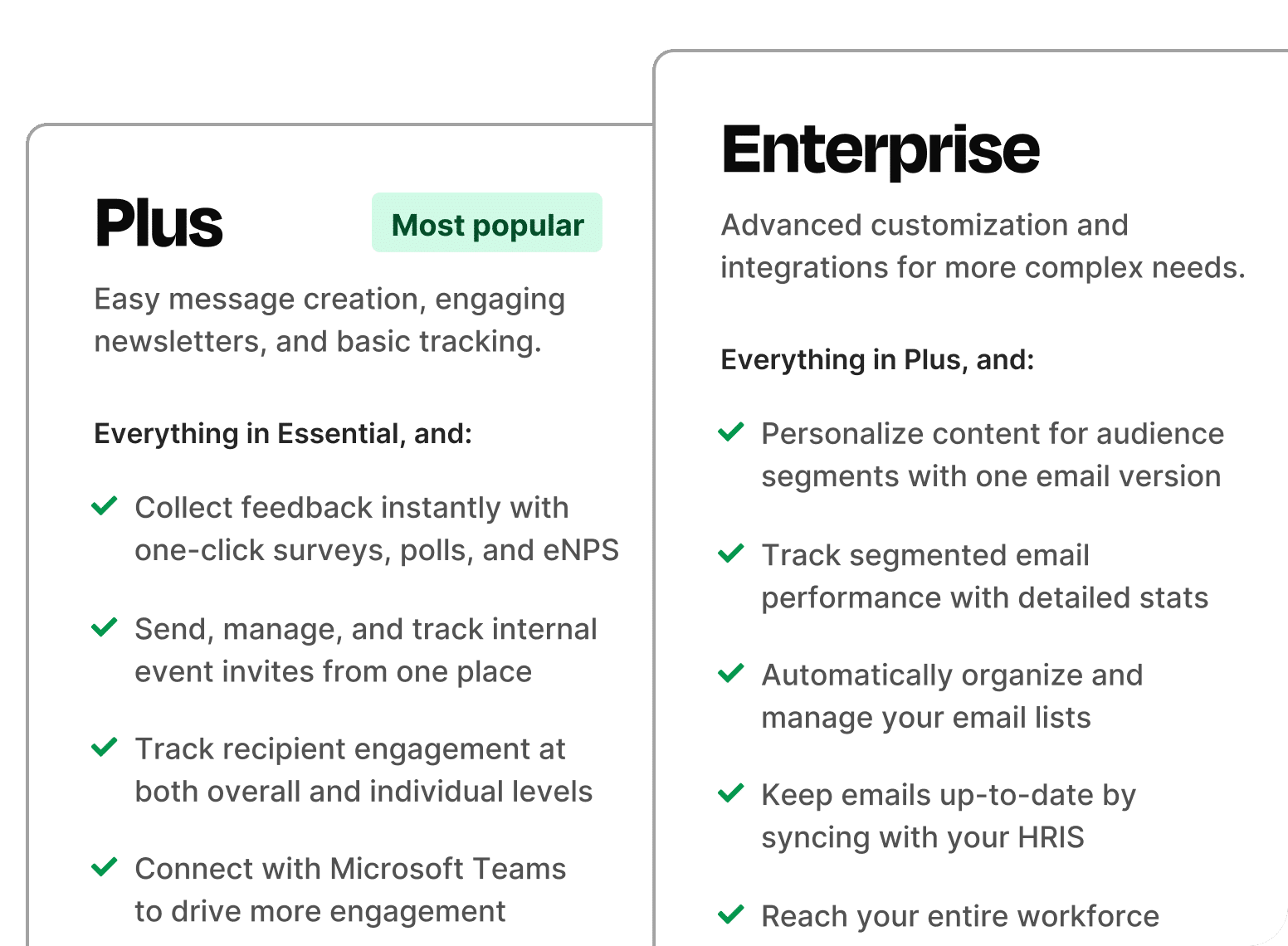
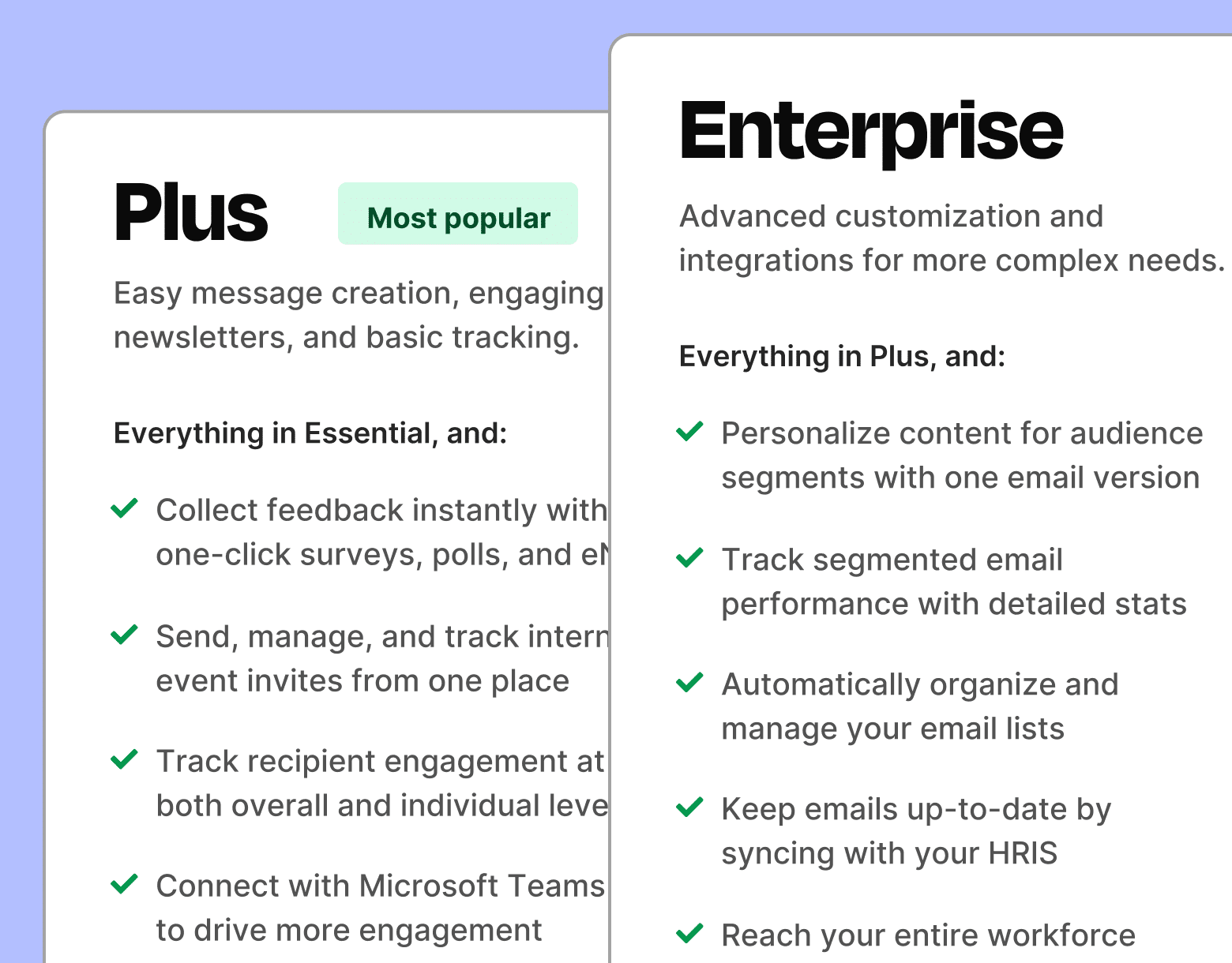
5. Internal career opportunities
Sharing internal job postings or career advancement paths fosters loyalty and retention.
Why it works: When employees see tangible growth opportunities, they’re more likely to remain engaged and motivated.
Tips to execute:
- Dedicate employee newsletter content specifically for open roles.
- Provide employee content ideas about upskilling or cross-department training.
- Encourage referrals by offering referral bonuses or recognition.
Actionable example: In your staff newsletter content examples, feature a “Career Corner” every two weeks. Include not just open positions but also spotlights on employees who transitioned into new roles successfully.
Considerations:
- Keep the listings concise; link to full descriptions on your intranet or HR portal.
- Highlight required skills and potential growth paths for clarity.
PRO TIP
In addition to job titles, share short employee testimonials about their experience moving vertically or laterally within the company. This can be powerful employee content marketing for your internal talent pool.
6. Pulse surveys and feedback loops
Frequent pulse surveys offer quick, actionable insights into how employees feel about various topics.
Why it works: Whether employees are satisfied with remote work policies or excited about a new project, these short surveys create a culture of listening.
Tips to execute:
- Keep questions limited—no more than five at a time.
- Use anonymous feedback to encourage honesty.
- Share survey results and next steps to validate employee input.
Actionable example: Send a weekly, one-question pulse survey via email or your intranet. Focus on topics like team collaboration, workload balance, or new initiatives. Summarize the findings in your employee newsletter content the following week.
Considerations:
- Repeatedly asking for feedback without acting on it can backfire.
- Mix quantitative (rating scales) and qualitative (open-ended) questions.
PRO TIP
Incorporate these surveys into a broader employee content management system, where data is stored and tracked for trends over time. Share major takeaways in your employee content strategy meetings so leaders can make informed decisions.
Start two-way conversations and employee feedback loops
Learn how to engage staff with pulse surveys, content ratings and reactions, custom polls, and more. Ready to send modern emails?
See engagement features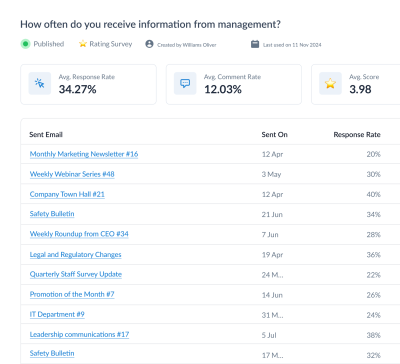
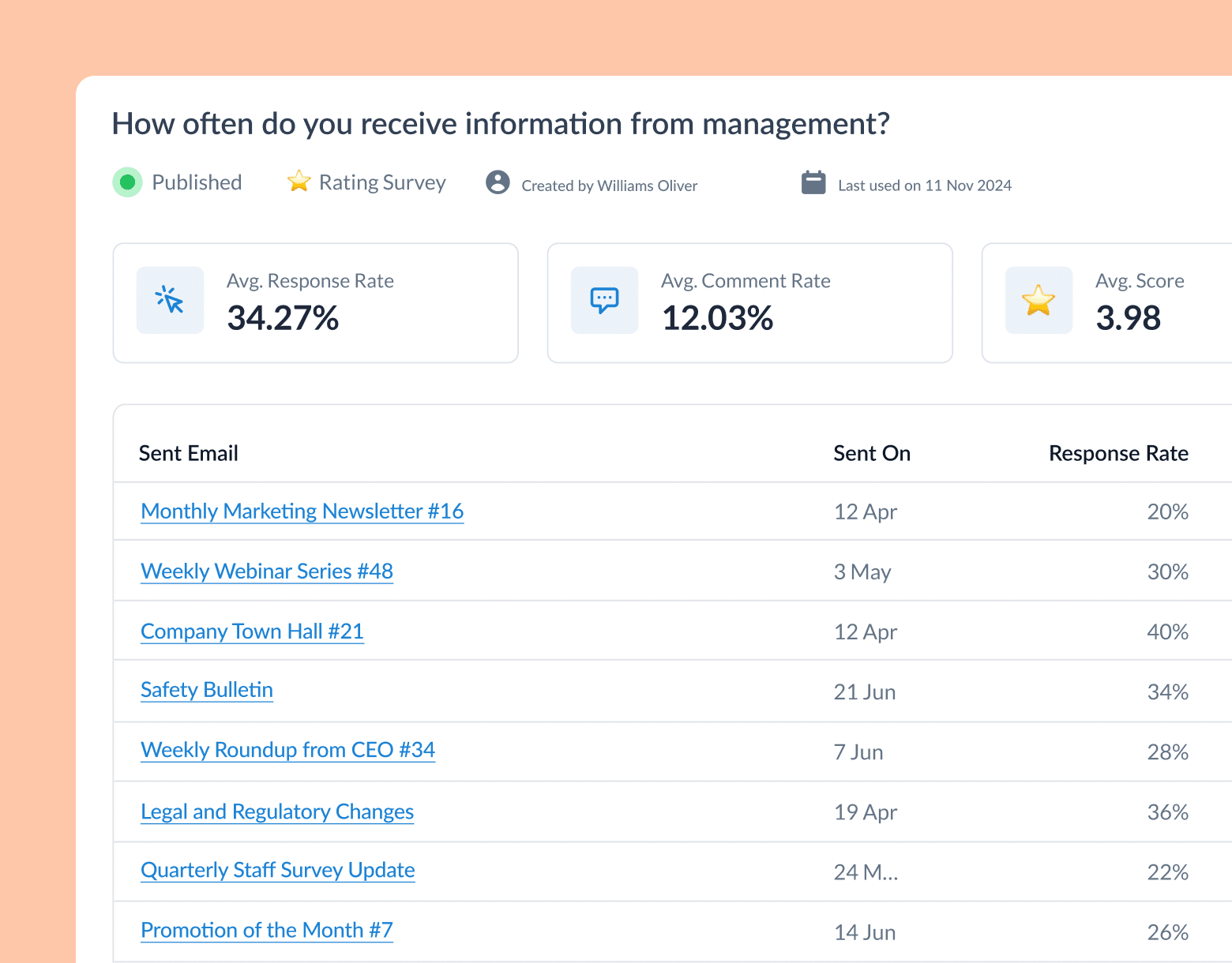
7. Corporate communication
Employees want more than just updates—they want to understand the bigger picture, connect with company values, and see how their work contributes to success.
Why it works: Consistently sharing culture-driven employee content—such as CSR initiatives, leadership insights, and company milestones—strengthens alignment and engagement. Meaningful corporate communication creates a sense of belonging and reinforces the organization’s mission, ultimately improving retention and collaboration.
Tips to execute:
- Use employee content marketing techniques—like storytelling—to make corporate messages more engaging.
- Dedicate a section of your staff newsletter content to highlighting corporate social responsibility efforts and company achievements.
- Encourage leaders to share personal reflections on company culture, business challenges, and success stories.
Actionable example: Feature a community outreach event in your next internal email. Include compelling visuals, employee testimonials, and a direct link to future volunteer opportunities. Emphasize how these initiatives align with company values and long-term goals.
Considerations:
- Avoid overly polished, corporate jargon—authenticity resonates more deeply.
- Always connect cultural stories to broader business objectives, reinforcing why they matter.
PRO TIP
Make corporate storytelling a two-way conversation. Invite employees to submit personal success stories, team wins, or impact-driven projects to be featured in your employee content strategy. This fosters engagement and ensures corporate messaging feels inclusive and relatable.
8. New employee content and onboarding
First impressions matter. New employee content can set the tone for how new hires perceive your organization, equipping them with the resources they need to succeed.
Why it works: Well-structured onboarding materials are crucial for speeding up the integration process and boosting early-stage engagement.
Tips to execute:
- Combine text-based resources (like an “Onboarding 101” PDF) with interactive sessions or videos.
- Introduce newbies in your employee newsletter content ideas, helping current employees see who’s joining the team.
- Provide a go-to FAQ document that addresses common questions.
Actionable example: Email a “Welcome Kit” to each new hire, containing an organizational chart, a short video from the CEO, and links to essential tools. Next, showcase them in your employee newsletter content so the rest of the company can greet them.
Considerations:
- Keep materials updated; outdated info sends the wrong message.
- Include an onboarding checklist to guide managers and mentors.
BONUS: Whether you have a hybrid or remote team, leverage these best practices to craft a digital employee onboarding strategy.
🎁BONUS
Whether you have a hybrid or remote team, leverage these best practices to craft a digital employee onboarding strategy.
9. Training materials and educational resources
Support continuous learning with easily accessible training content.
Why it works: Ongoing professional development is a major motivator for employees. When they see clear, relevant employee training content or have access to an employee training program content library, they feel valued and equipped to grow. This also contributes to better job performance and lower turnover.
Tips to execute:
- Host short webinars or lunch-and-learn sessions.
- Provide digital modules for employee education content that can be accessed anytime.
- Encourage a continuous learning culture by highlighting staff who complete certifications or skill-building courses.
Actionable example: Create a monthly training spotlight in your content for employee newsletter, offering a short tutorial or infographic on improving a job-specific skill. Add quick tips and a link to a more in-depth module.
Considerations:
- Diversify content formats (videos, PDFs, interactive quizzes) for different learning styles.
- Track completion rates to gauge effectiveness.
🎁 BONUS
Take advantage of our resources and launch your training sessions with this training announcement email to employees.
Get powerful email analytics and reporting features
Know exactly who is opening and engaging with your employee communications and company newsletters.
Explore analytics & reporting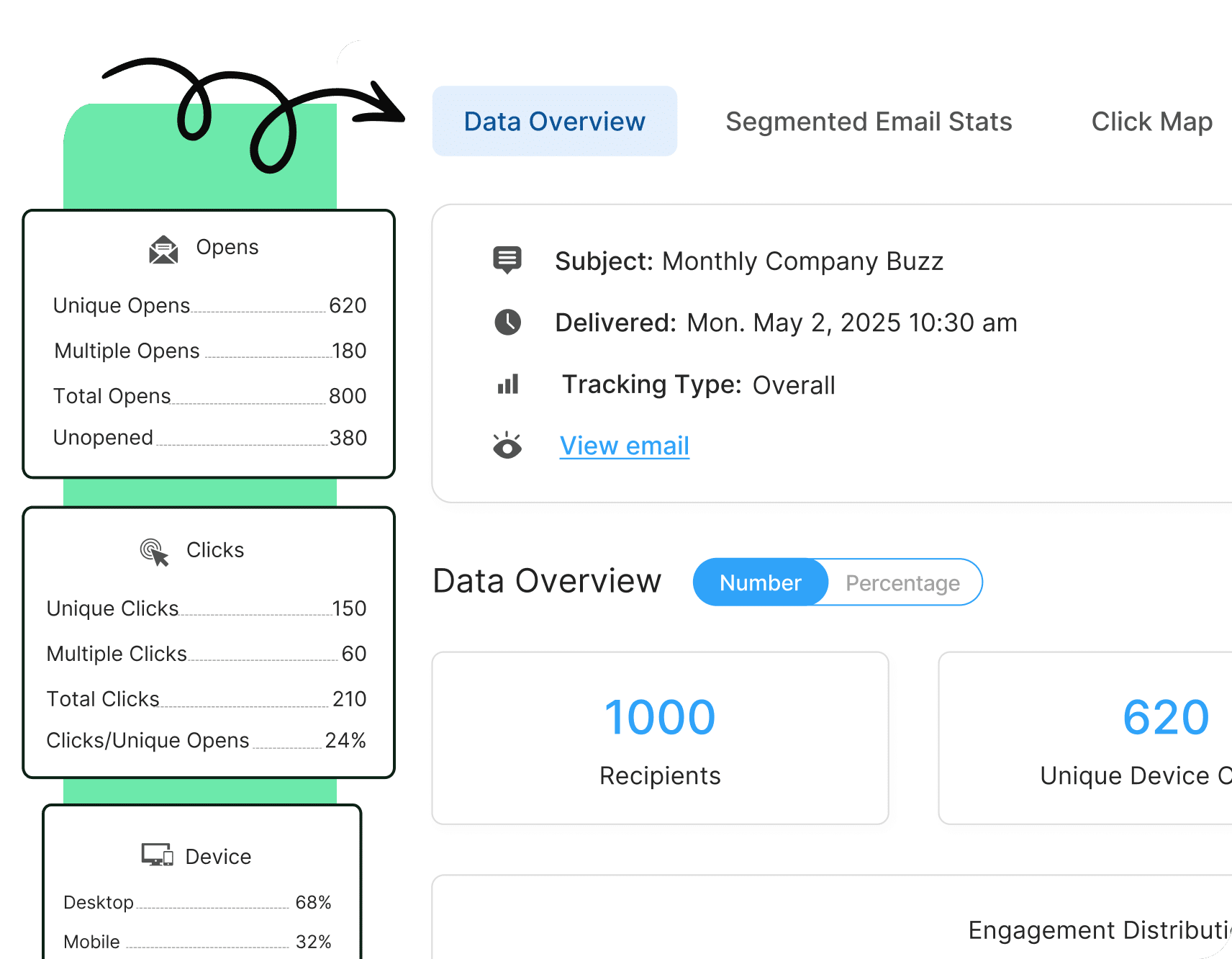
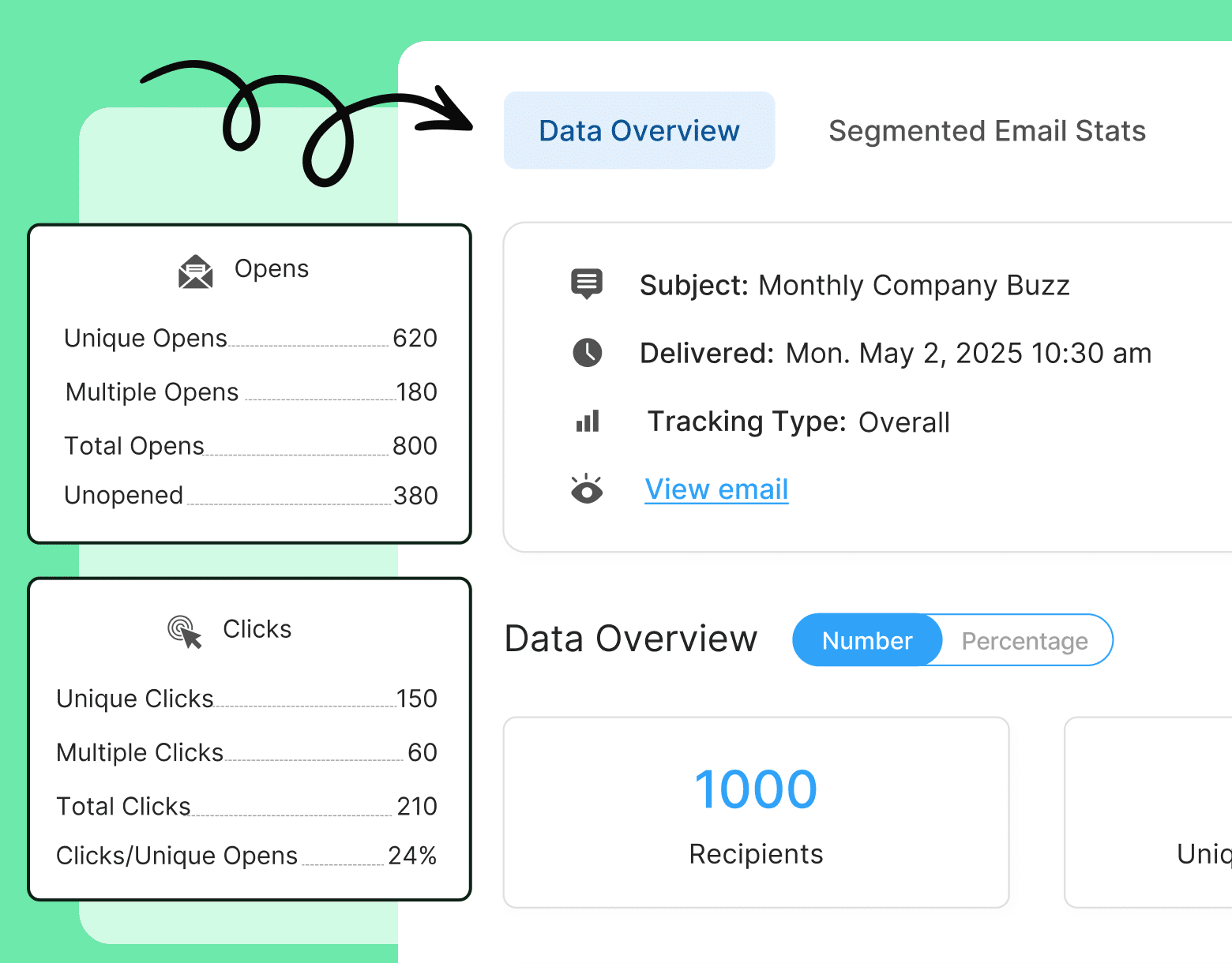
10. Accomplishments and accolades
Celebrate company and individual successes to build team spirit.
Why it works: Celebrating wins—whether they’re major deals, industry awards, or successful team outings—instills pride and camaraderie. Incorporating pics of work social events or highlighting major successes signals that your organization values both collective and individual achievements.
Tips to execute:
- Dedicate sections in your employee newsletter content to showcase recent accolades.
- Encourage employees to submit photos and anecdotes from social events.
- Integrate “Year in Review” segments to highlight milestones and big wins.
Actionable example: Create a quarterly “Accomplishments Digest” as employee engagement content, featuring staff awards, event recaps, and personal achievements. Include plenty of visuals—photos or short videos—to evoke emotion and excitement.
Considerations:
- Keep the tone uplifting but genuine. Overhyping small wins can dilute the impact of significant accomplishments.
- Be inclusive by featuring multiple departments and role levels.
PRO TIP
Align social event coverage with your employee content marketing plan. Positive internal stories can be adapted for external channels like LinkedIn or your careers page, showcasing a vibrant company culture.
Measuring Employee Content Engagement After Sending Emails
Now that we’ve outlined 10 types of employee content, moving on to measurement – what you’ll be able to leverage to prove the impact of your efforts.
Why Measurement Matters
Tracking open rates, click-through rates, survey feedback, and direct responses tells you which employee content ideas truly resonate. This data-driven approach refines your employee content management process, helping you decide how to create content for employee engagement that’s not just seen but acted upon.
Methods and Tools for Better Insights
Leverage analytics tools—like ContactMonkey’s analytics dashboard feature— to monitor real-time engagement. By understanding which employee content examples spark discussion or prompt action, you can fine-tune your employee content strategy. For instance, if a particular type of employee content (like podcasts) garners more clicks and commentary, consider producing similar formats more frequently.
Review data such as:
- Email open and click rates
- Internal survey results
- Time spent on training modules
- Feedback from managers and team leads
These indicators help you spot trends, address gaps, and iterate on how to create content for employee engagement more effectively. For deeper guidance on measuring newsletter success, check out our article on measuring employee newsletter performance.
15 employee templates to recognize your team’s hard work
Show your team they matter with these sample appreciation emails.
Get templates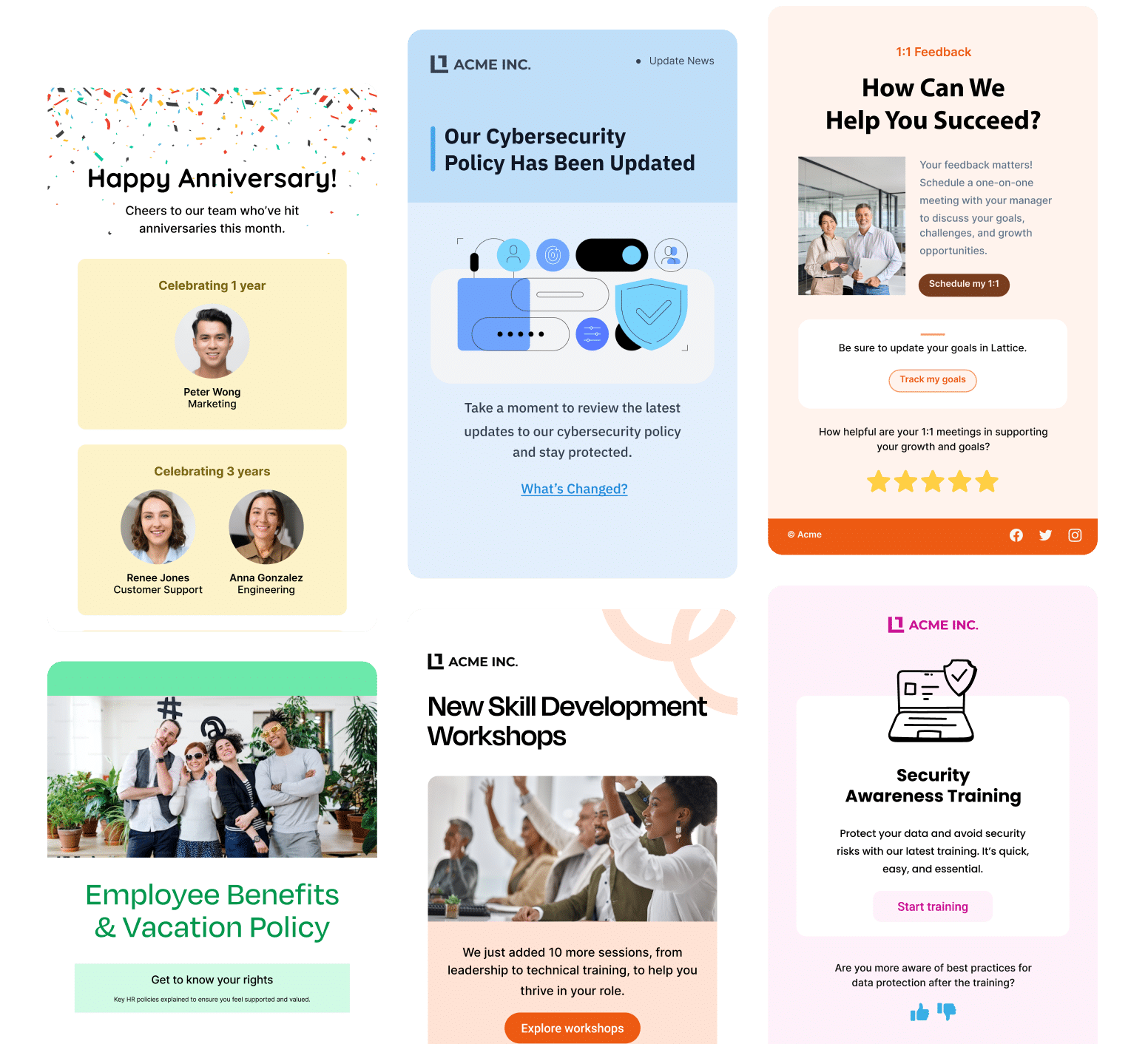
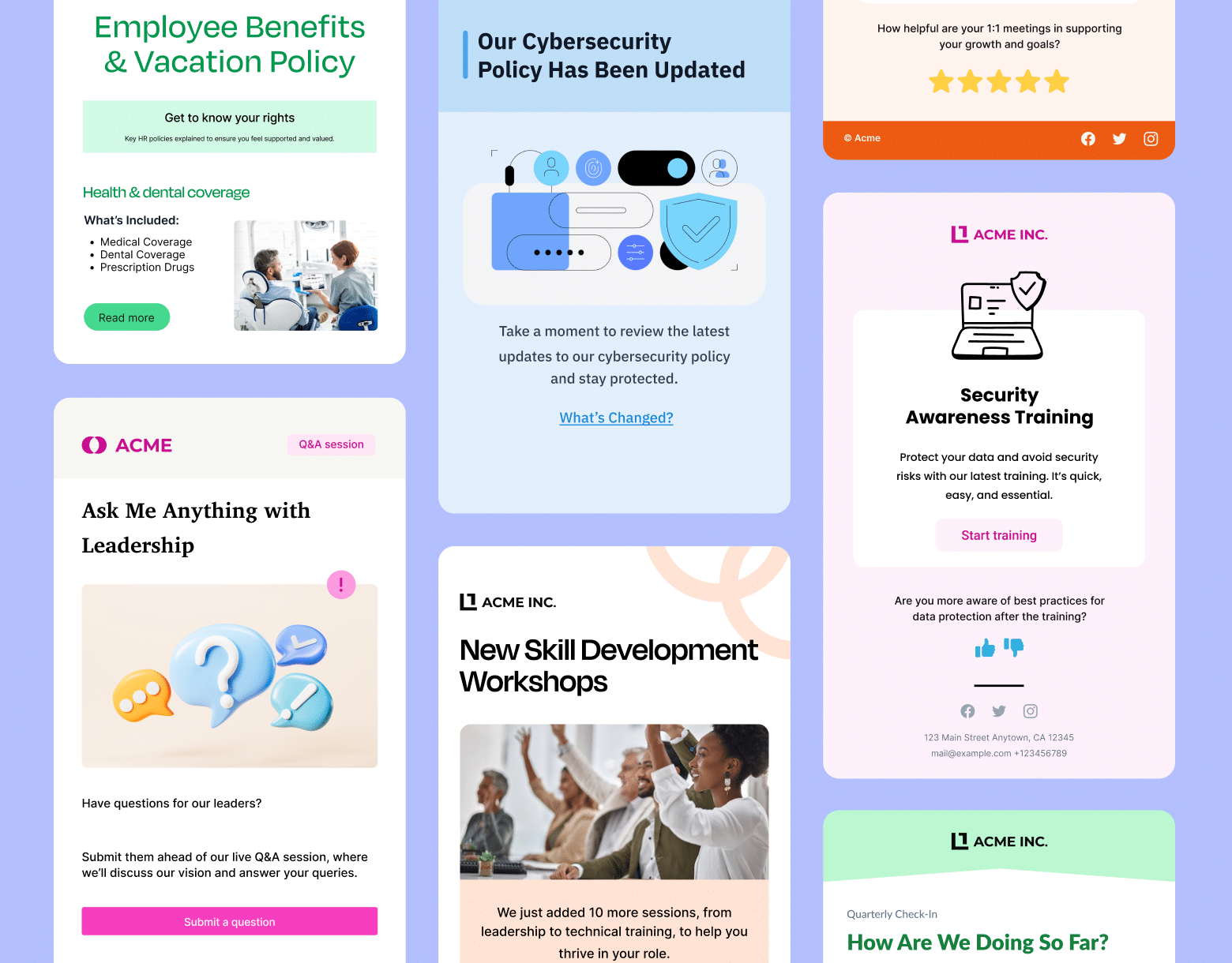
How to Elevate Employee Engagement with ContactMonkey
Below is a reformatted list showcasing ContactMonkey’s features. Each heading is followed by succinct descriptions, mirroring your requested style:
- Drag-and-drop email template builder: Craft visually engaging, mobile-responsive emails—no coding required. Customize elements (banners, GIFs, survey blocks) to match your brand’s look and feel, thanks to the email template builder feature.
- Dynamic content: Through our dynamic content feature, Send personalized messages to different segments in a single email. Deliver relevant announcements, updates, or news based on role, location, or department.
- Real-time analytics and reporting: The email analytics feature instantly tracks open rates, click-through rates, and read times. Compare campaign performance to spot trends and refine your internal communications strategy.
- Built-in surveys and pulse checks: Embed pulse surveys, star ratings, or emoji reactions directly into emails through the employee feedback feature. Gather employee feedback quickly without sending them to external pages.
Ready to improve your employee engagement? Book a free demo with one of our experts to chat more about how ContactMonkey can support your IC practice.

